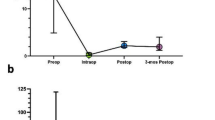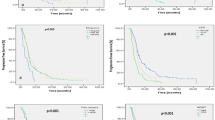Abstract
Background
Current treatments in grade III gliomas include surgery, radiotherapy, and chemotherapy. The value of the entity of surgical resection remains an open question. The aim of this evaluation was to analyze the impact of extent of resection (EOR) and residual tumor volume (RTV) on progression-free survival (PFS) and overall survival (OS) in patients with newly diagnosed grade III gliomas.
Methods
Overall, 136 patients were included in this evaluation. EOR and RTV were defined in all patients on postoperative volumetric magnetic resonance imaging, with EOR being defined as the rate of surgical resection, and RTV as contrast-enhancing RTV (CE-RTV) and fluid-attenuated inversion recovery (FLAIR) RTV. A threshold of EOR and RTV was recorded using increments of 2 % and 1 cm3.
Results
EOR and RTV were the only clinical variables influencing PFS and OS. The EOR cut-off value for conditioning survival was 76 %. For EOR ≥76 % or <76 %, the 5- to 10-year PFS was 57 % and 18 % versus 0 % (p = 0.03), and 5- to 10-year OS was 68 % and 42 % versus 0 % (p = 0.06), respectively. Additionally, the RTV cut-off value was 3 cm3; for RTV <3 cm3 or >3 cm3, 5- to 10-year PFS was 64.3 % and 48.2 % versus 42 % and 0 % (p = 0.02), and 5- to 10-year OS was 66.8 % and 33.4 % versus 56 % and 0 % (p = 0.3), respectively. RTV was a more significant parameter conditioning PFS and OS than EOR (p = 0.04), and the presence of CE-RTV was an unfavorable prognostic factor compared with FLAIR-RTV.
Conclusions
In heterogeneous lesions from a radiological point of view as WHO grade III gliomas if a complete removal is not possible, it would be advisable to maximize the removal of enhancing areas, possibly with an EOR >76 % and an RTV <3 cm3.



Similar content being viewed by others
References
Brell M, Tortosa A, Verger E, et al. Prognostic significance of O6-methylguanine DNA methyltransferase determined by promoter hypermethylation and immunohistochemical expression in anaplastic gliomas. Clin Cancer Res. 2005;11:5167–74.
Bauman G, Ino Y, Ueki K, et al. Allelic loss of chromosome 1p and radiotherapy plus chemotherapy in patients with oligodendrogliomas. Int J Radiat Oncol Biol Phys. 2000;48:825–30.
Chahlavi A, Kanner A, Peereboom D, Staugaitis SM, Elson P, Barnett G. Impact of chromosome 1p status in response of oligodendroglioma to temozolomide: preliminary results. J Neurooncol. 2003;61:267–73.
Thiessen B, Maguire JA, McNeil K, Huntsman D, Martin MA, Horsman D. Loss of heterozygosity for loci on chromosome arms 1p and 10q in oligodendroglial tumors: relationship to outcome and chemosensitivity. J Neurooncol. 2003;64:271–78.
Jiang H, Ren X, Cui X, et al. 1p/19q codeletion and IDH1/2 mutation identified a subtype of anaplastic oligoastrocytomas with prognosis as favorable as anaplastic oligodendrogliomas. Neuro Oncol. 2013;15:775–82.
Frenel J, Leux C, Loussouarn D, et al. Combining two biomarkers, IDH1/2 mutations and 1p/19q codeletion, to stratify anaplastic oligodendroglioma in three groups: a single-center experience. J Neurooncol. 2013;114:85–91.
Olar A, Wani K, Alfaro-Munoz K, et al. IDH mutation status and role of WHO grade and mitotic index in overall survival in grade II–III diffuse gliomas. Acta Neuropathol. 2015;129:585–96.
The Cancer Genome Atlas Research Network. Comprehensive, integrative genomic analysis of diffuse lower-grade gliomas. N Engl J Med. 2015;372:2481–98.
Wick W, Hartmann C, Engel C, et al. NOA-04 randomized phase III trial of sequential radiochemotherapy of anaplastic glioma with PCV or temozolomide. J Clin Oncol. 2009;35:5874–80.
Yamaguchi S, Kobayashi H, Terasaka S, et al. The impact of extent of resection and histological subtype on the outcome of adult patients with high-grade gliomas. Jpn J Clin Oncol. 2012;42(4)270–77.
McGirt MJ, Chaichana KL, Gathinji M, et al. Independent association of extent of resection with survival in patients with malignant brain astrocytoma. J Neurosurg. 2009;110:156–62.
Cohen ZR, Suki D, Shi W, et al. Surgical resection of anaplastic astrocytoma: prognostic factors and outcome. Neuro Oncol. 2002;4:367–72
Castellano A, Bello L, Michelozzi C, et al. Role of diffusion tensor magnetic resonance tractography in predicting the extent of resection in glioma surgery. Neuro Oncol. 2012;14:192–202.
Sanai N, Berger MS. Glioma extent of resection and its impact on patient outcome. Neurosurgery. 2008;62:753–64.
Smith JS, Chang EF, Lamborn KR, et al. Role of extent of resection in the long-term outcome of low-grade hemispheric gliomas. J Clin Oncol. 2008;26:1338–45.
Chaichana KL, Jusue-Torres L, Navarro-Ramirez R, et al. Establishing percent resection and residual volume thresholds affecting survival and recurrence for patients with newly diagnosed intracranial glioblastoma. Neuro Oncol. 2014;16:113–22.
Grabowski MM, Recinos PF, Nowacki AS, et al. Residual tumor volume versus extent of resection: predictors of survival after surgery for glioblastoma. J Neurosurg. 2014;121:1115–23.
Smith JS, Cha S, Mayo MC, et al. Serial diffusion-weighted magnetic resonance imaging in cases of glioma: Distinguishing tumor recurrence from postresection injury. J Neurosurg. 2005;103:428–38.
Wen P, Macdonald D, Reardon D, et al. Updated response assessment criteria for high-grade gliomas: response assessment in neuro-oncology working group. J Clin Oncol. 2010;28:1963–72.
Stummer W, Reulen HJ, Meinel T, et al. Extent of resection and survival in glioblastoma multiforme: identification of and adjustment for bias. Neurosurg. 2008;62:564–76.
Sanai N, Polley MY, McDermott MW, Parsa AT, Berger MS. An extent of resection threshold for newly diagnosed glioblastomas. J Neurosurg. 2011;115:3–8
Disclosure
Luca Cozzi acts as a Scientific Advisor to Varian Medical Systems and is Clinical Research Scientist at Humanitas Cancer Center. Federico Pessina, Pierina Navarria, Anna Maria Ascolese, Matteo Simonelli, Armando Santoro, Stefano Tomatis, Marco Riva, Enrica Fava, Marta Scorsetti, and Lorenzo Bello have no conflicts of interest to declare.
Author information
Authors and Affiliations
Corresponding author
Rights and permissions
About this article
Cite this article
Pessina, F., Navarria, P., Cozzi, L. et al. Value of Surgical Resection in Patients with Newly Diagnosed Grade III Glioma Treated in a Multimodal Approach: Surgery, Chemotherapy and Radiotherapy. Ann Surg Oncol 23, 3040–3046 (2016). https://doi.org/10.1245/s10434-016-5222-3
Received:
Published:
Issue Date:
DOI: https://doi.org/10.1245/s10434-016-5222-3




